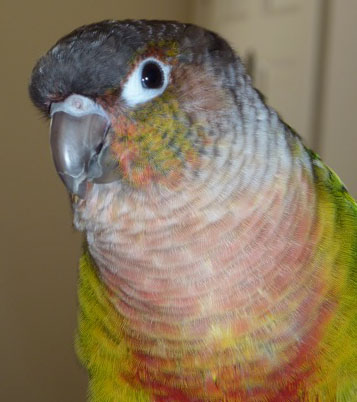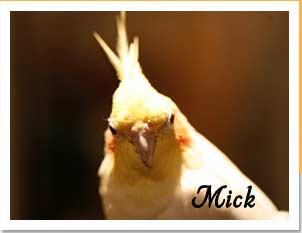Ancestors of our Birds: Agile, Cunning, Feathered, and… Toothed?
by Tanya Renner
After watching the movie Jurassic Park countless times and experiencing the scene of the Velociraptor in the kitchen, I am more than confident my foster green-cheeked conure ‘Purby’ descended from a dinosaur. However, there is much more evidence for a close relationship between birds and dinosaurs than an interpretation of behavior from a Hollywood movie.
You may have heard that birds evolved from dinosaurs, but it’s a little more complicated than T-Rex slowly becoming a chicken over time! Some scientists think that birds shared an ancient common ancestor with only a certain group of dinosaurs, and over time, birds and dinosaurs took separate evolutionary paths.
Which types of bird-like dinosaurs do paleontologists think are closely related to modern birds and when do we start to see early birds in the fossil record? Has a fossil of Purby’s ancestor been found? In this article we will explore the origin of birds (and parrots!) by taking a look at a few fossil finds that have helped scientists further understand how modern birds arose.
Invasion of the ‘Hand-Snatchers’
Scientists place birds or Aves in a large clade called Maniraptora (‘hand-snatchers’); a group of organisms that includes dinosaurs like Velociraptor. Maniraptora share numerous features related to a bird's body plan, but the most obvious is the presence of long forearms and hands that could have been used for grasping. It is in the Aves and their closest relatives that we start to notice modifications of these long forearms and hands, which may have been co-opted for flight.
Microraptor: Your Pigeon’s Second Cousin
Can you imagine your foster King pigeon with four wings? Weighing in around 2 pounds and about 2 feet long, Microraptor was about the size of a large pigeon. Classified by scientists as a non-bird dinosaur and a possible ‘cousin’ to the Aves, Microraptor had long contour feathers on its tail, forearms, and hind legs. This meant species of Microraptor had four wings like a biplane, each capable of providing some lift for gliding! Yet the wings found on the hind legs would have been problematic when Microraptor landed on the ground, as the feathers that made up these wings were actually anchored to the feet and would have hindered walking or running. Based on this observation, Microraptor probably spent most of his time in the tree canopies gliding around searching for prey 125 million years ago. So why do we not see four-winged pigeons today? It could be possible that this biplane design was an evolutionary dead-end or just a stepping-stone to two-winged flight in modern birds.
Familiar Ancestors
As scientists continue to find fossils, the distinction between bird and non-bird dinosaurs becomes increasingly difficult. Microraptor is an example of this scenario where a recent fossil with feathers and the capability of limited flight was placed in a group outside of the Aves due to features that made Microraptor more dinosaur-like than bird-like. So which features make a bird a bird? Let’s take a look at three ancestors to modern birds to answer this question.
Scansoriopteryx: Let’s Leap
As small as a sparrow, Scansoriopteryx was an arboreal (tree-living) dinosaur with arms that would have folded similarly to a modern bird’s, allowing for leaping between branches and possibly flight. Probably an avid tree-climber, Scansoriopteryx had features similar to modern tree-dwelling birds like woodpeckers: feet with a backward-pointing toe and a short tail for propping itself upright on tree trunks. Down-like feathers are evident in the fossil impressions of Scansoriopteryx, but so are scales at the base of the tail!
Archaeopteryx: Ancient Wings
Scientists first pondered over the close relationship between birds and dinosaurs when a 150 million-year-old fossil known as Archaeopteryx (archaeo = ancient, pteryx = wing) was unearthed in Berlin, Germany in 1861. Archaeopteryx provided a perfect example of the transition from dinosaur to bird as the specimen had features of both: sharp teeth, three-fingered claws, a sharp ‘killing claw’ on the second toe, a long bony tail, and feathers that were well developed for flight and insulation. Flapping around the same time as Brachiosaurus (“veggie-saurus” in Jurassic Park), this little guy weighed in close to 270 grams, and was no larger than the size of a smaller Amazon parrot.
Confuciusornis: Old Crow
A genus of crow-sized birds from the early Cretaceous (~125 million years ago), Confuciusornis was a primitive bird with a pygostyle (a bone formed from fused tail vertebrae) and toothless beak—characteristics of modern birds and features Archaeopteryx did not have. Yet unlike modern birds, it had large claws on its forearms and was unable to produce flapping flight as the position of the shoulder joint did not allow Confuciusornis to lift its wings up and over its back. In the air, this bird probably glided like Scansoriopteryx and Archaeopteryx, but when on the ground, ran and hopped similar to what we see modern crows do today. Interestingly, earlier this year scientists utilized an electron microscope to identify certain pigments found in Confuciusornis fossils, which indicate feathers had hues of grey, red, brown, and black.
Modern Birds
Modern birds comprise the first (and now extinct) birds on earth in addition to all living birds today. Whether extinct or extant, modern birds share a variety of features, which include the presence of feathers, a toothless beak, production of hard-shelled eggs, a four-chambered heart, lightweight skeleton, and two-winged flight—with the exception of some species such as penguins. Within the last few years two exciting modern bird fossil finds have been made, one of which is an ancestor of the parrots.
Pelagornis: Pseudoteeth
Some extinct modern birds were amazing in their size, morphology, and certainly would have been very daunting if you came across one! Of these awesome birds is a type of Pelagornis, a group of extinct seabirds closely related to pelicans with wingspans up to 20 feet—some of the largest birds to have ever lived. The most notable morphological feature of these 2.5-23 million year old birds is the presence of pseudoteeth; serrated structures at the beak edge that may have functioned in prey capture. Although pseudoteeth may resemble true teeth at first glance, they were much different anatomically from the true teeth found in Microraptor, Scansoriopteryx, and Archaeopteryx.
Mopsitta: Purby’s Danish Ancestor
The oldest parrot fossil described lived in quite an unexpected place: what is now Denmark! Named Mopsitta, this ancient parrot flew among what were once lush and tropical landscapes 54 million years ago. Evidence of parrots in Scandinavia may suggest that parrots first evolved in the Northern Hemisphere and later diversified into the species we find later in the fossil record from the Southern Hemisphere.
What do you think this ancient parrot looked like? Did he have zygodactyl feet (2 toes facing forward and backward) and a curved bill? Although we know Mopsitta was about the size of a lesser sulfur-crested cockatoo, we do not have much information on what this ancient parrot could have really looked like. What we know about Mopsitta is based entirely upon fossil remains of a single humerus, a long arm bone that runs from the shoulder to the elbow. This bone has very similar attributes in shape to a humerus found in today’s parrots. So, your guess is as good as mine as to what other features Mopsitta would have had!
All in the Family
It is apparent that the evolution of birds is pretty complicated. Having feathers does not automatically categorize an animal as a bird. It is a combination of certain features that defines a bird, many of which we can identify in our Mickaboo birds today. Next time you say hello to your feathered kid, take a good look at his or her feathers, toothless beak, and wings. You might be able to identify which features are similar to those in ancient birds or dinosaurs.
References and Further Reading on the Evolution of Birds
Bourdon, E. (2005). Osteological evidence for sister group relationship between pseudo-toothed birds (Aves: Odontopterygiformes) and waterfowls (Anseriformes). Naturwissenschaften. Vol. 92(12): 586–591.
Chatterjee, S., and Templin, R.J. (2007). "Biplane wing platform and flight performance of the feathered dinosaur Microraptor gui." Proceedings of the National Academy of Sciences, 104(5): 1576-1580.
Chiappe, Luis M., Shu-An, Ji, Qiang, Ji, Norell, Mark A. (1999). Anatomy and systematics of the Confuciusornithidae (Theropoda: Aves) from the Late Mesozoic of northeastern China. Bulletin of the American Museum of Natural History. Vol. 242.
Christensen P, Bonde N. (2004). Body plumage in Archaeopteryx: a review, and new evidence from the Berlin specimen. Comptes Rendus Palévol. Vol. 3: 99–118.
Czerkas, S.A., and Yuan, C. (2002). An arboreal maniraptoran from northeast China. Pp. 63-95 in Czerkas, S.J. (Ed.), Feathered Dinosaurs and the Origin of Flight. The Dinosaur Museum Journal 1. The Dinosaur Museum, Blanding, U.S.A.
Gauthier, J. and de Queiroz, K. (2001). Feathered dinosaurs, flying dinosaurs, crown dinosaurs, and the name "Aves". 7-41 in Gauthier, J. and L.F. Gall (eds.), New Perspectives on the Origin and Early Evolution of Birds: Proceedings of the International Symposium in Honor of John H. Ostrom. New Haven: Peabody Museum of Natural History, Yale University.
Lindow, B.E.K., and Dyke, G.J. (2006). Bird evolution in the Eocene: climate change in Europe and a Danish fossil fauna. Biological Reviews. Vol. 81: 483-499. Cambridge University Press.
Maniraptora (“Seizing Hands”)- University of California, Berkeley Museum of Paleontology. http://www.ucmp.berkeley.edu/diapsids/saurischia/maniraptora.html
Norell, M., and Ellison, M. (2005). Unearthing the Dragon: The Great Feathered Dinosaur Discovery. New York: Pi Press.
Owen, R. (1863). On the Archaeopteryx of Von Meyer, with a description of the fossil remains of a long-tailed species from the lithographic stone of Solnhofen. Phil. Trans. Roy. Soc. London. Vol. 153: 33–47.
Senter, P. (2006). Scapular orientation in theropods and basal birds, and the origin of flapping flight. Acta Palaeontologica Polonica, Vol. 51(2): 305–313.
Xu et al. (2003). Four winged dinosaurs from China. Nature. Vol. 421, 335 – 340.
Yalden D.W. (1984). "What size was Archaeopteryx?" Zoological Journal of the Linnean Society. Vol. 82(1-2): 177–188.
Are Birds Really Dinosaurs?- University of California, Berkeley Museum of Paleontology. http://www.ucmp.berkeley.edu/diapsids/avians.html.
Waterhouse, D.M.; Lindow, B.E.K.; Zelenkov, N.V. and Dyke, G.J. (2008). Two new parrots (Psittaciformes) from the Lower Eocene Fur Formation of Denmark. Palaeontology. Vol. 59(3): 575–582.

